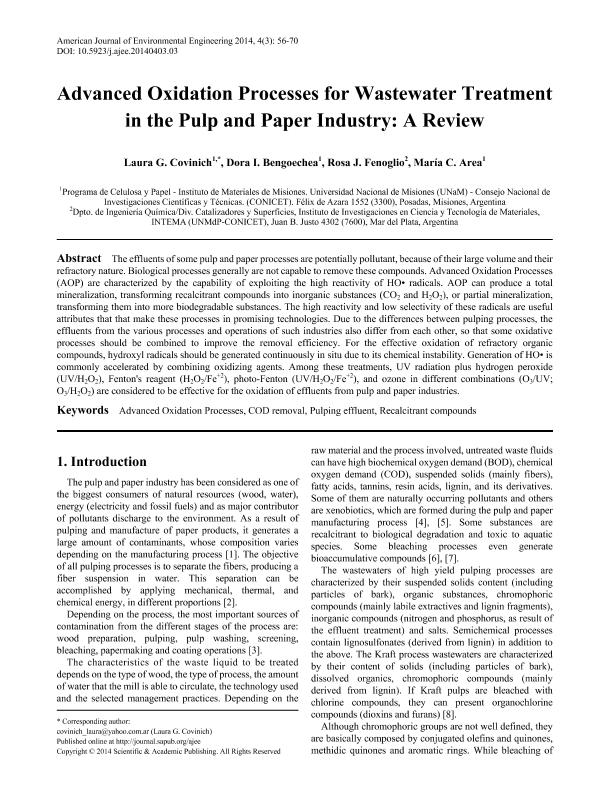Artículo
Advanced oxidation processes for wastewater treatment in the pulp and paper industry: a review
Fecha de publicación:
05/2014
Editorial:
Scientific & Academic Publishing
Revista:
American Journal of Environmental Engineering
ISSN:
2166-4633
e-ISSN:
2166-465X
Idioma:
Inglés
Tipo de recurso:
Artículo publicado
Clasificación temática:
Resumen
The effluents of some pulp and paper processes are potentially pollutant, because of their large volume and their refractory nature. Biological processes generally are not capable to remove these compounds. Advanced Oxidation Processes (AOP) are characterized by the capability of exploiting the high reactivity of HO• radicals. AOP can produce a total mineralization, transforming recalcitrant compounds into inorganic substances (CO2 and H2O2), or partial mineralization, transforming them into more biodegradable substances. The high reactivity and low selectivity of these radicals are useful attributes that that make these processes in promising technologies. Due to the differences between pulping processes, the effluents from the various processes and operations of such industries also differ from each other, so that some oxidative processes should be combined to improve the removal efficiency. For the effective oxidation of refractory organic compounds, hydroxyl radicals should be generated continuously in situ due to its chemical instability. Generation of HO• is commonly accelerated by combining oxidizing agents. Among these treatments, UV radiation plus hydrogen peroxide (UV/H2O2), Fenton's reagent (H2O2/Fe+2), photo-Fenton (UV/H2O2/Fe+2), and ozone in different combinations (O3/UV; O3/H2O2) are considered to be effective for the oxidation of effluents from pulp and paper industries.
Archivos asociados
Licencia
Identificadores
Colecciones
Articulos(CCT - NORDESTE)
Articulos de CTRO.CIENTIFICO TECNOL.CONICET - NORDESTE
Articulos de CTRO.CIENTIFICO TECNOL.CONICET - NORDESTE
Articulos(IMAM)
Articulos de INST.DE MATERIALES DE MISIONES
Articulos de INST.DE MATERIALES DE MISIONES
Citación
Area, Maria Cristina; Fenoglio, Rosa Juana; Bengoechea, Dora Inés; Covinich, Laura Gabriela; Advanced oxidation processes for wastewater treatment in the pulp and paper industry: a review; Scientific & Academic Publishing; American Journal of Environmental Engineering; 4; 3; 5-2014; 56-70
Compartir
Altmétricas




